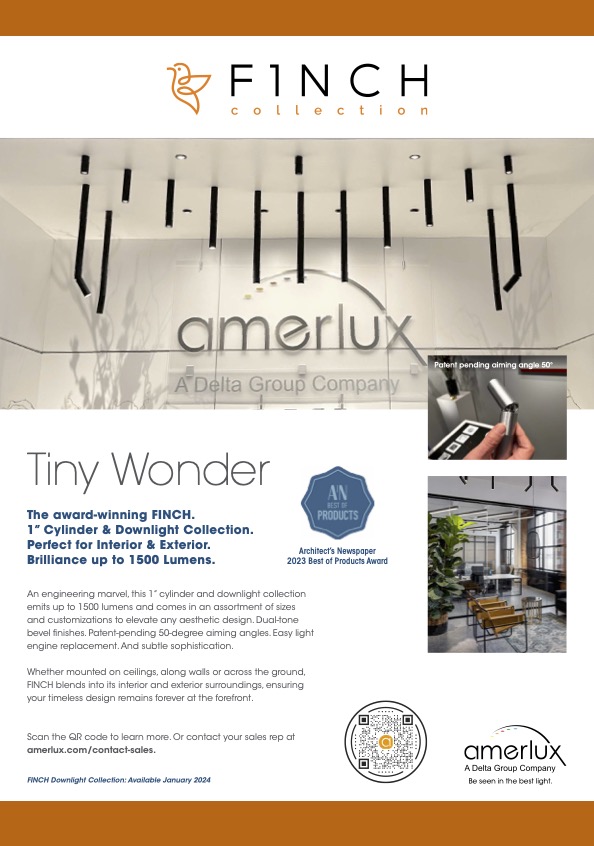
4 minute read
Reuse Goes Mainstream
The reuse of luminaires is being normalised. That was one of the key messages to come from the Circular Lighting Live 2023 conference in London in September.
The event, held at the Royal College of Physicians in London, brought together 290 delegates for the most comprehensive review of circular economy progress in the lighting industry.
A total of 35 speakers and panellists provided a fully comprehensive review of the legislation, and actions that companies in the UK and elsewhere are taking to drive forward the circular economy.
Major commercial real estate developers, their architects and design teams are beginning to either reuse existing luminaires by retrofitting upgrades, or in a few cases, use luminaires from a completely different building.
Delegates heard presentations from clients who had reused luminaires, included Rolls Royce, Cambridge University, The Holburne Museum, Dublin Port Tunnel and Building Craft College.
Chairman, Ray Molony said: ‘This imaginative new thinking is leading to new business models and the growth of a vibrant remanufacturing sector in the lighting industry.
Remanufacturers take used lights, upgrade them to the latest efficient LEDs and wireless controls and then, crucially, warranty them.”

Recolight Reuse Hub
The Recolight Reuse Hub was launched at the conference. It provides an online digital marketplace for the donation and reuse of lighting products. That can either be brand new unsold stock that will not be sold, or used product that could be remanufactured.
The regulatory landscape is set to change dramatically with many circular economy regulations and directives being developed at EU level. These include the Ecodesign for Sustainable Products Regulation (ESPR), Right to Repair legislation and a raft of other rules affecting green packaging, sustainability information, substantiating green claims, chemicals and waste. Maurice Maes, Head of Standards and Regulation at Signify, gave an essential
update on the regulations and how they will affect businesses in the lighting supply chain.
Maes told the audience: ‘It has been a fantastic experience to witness the green ambitions of the UK lighting industry and to see the many innovative circular designs and successful remanufacturing projects. I am sure the Recolight Circular Lighting Live event will further fuel and accelerate this amazing trend.’
Specifiers and end users now asking for a wide range of environmental metrics, including environmental product declarations (EPDs) life cycle assessment (LCAs), and embedded carbon calculations (such as TM65) and circularity assessments (eg TM66).
Leela Shanker, founder of the Life Cycle Assessment Incubator of the GreenLight Alliance and the IALD, said: ‘We need a global approach to align emerging carbon accounting and material transparency frameworks. This will allow us to keep moving with the best ideas from around the world, save designers time in upskilling, give manufacturers certainty on the business case for reporting and ultimately, accelerate implementation of circular design principles and decarbonisation strategies.’

The reuse and reconditioning of luminaires is increasingly being normalised, as a number of case studies at the Circular Lighting Live 2023 in London attest.
The GreenLight Alliance plans to publish EPDs from five types of generic fixtures and this can be used as a benchmark for specifiers. Greenlight has also issued a document with generic but meaningful language to help designers protect their specifications.
Delegates heard of the changes to CIBSE specifications TM65 (embedded carbon) and TM66 (circularity). Both Designing Lighting Global editor Ray Molony chaired the proceedings at Circular Lighting Live 2023

specifications were widely lauded as providing effective ways in which lighting producers can assess and publicise the sustainability of their products, and specifiers can compare the sustainability credentials of similar products.
The conference also highlighted considerable concerns regarding the level of waste associated with Cat A fitouts. All too often, brand new luminaires are removed and scrapped when a fully fitted out building is handed to new tenants. A number of solutions to tackling this waste were considered.
Summarising the event, Nigel Harvey, CEO of Recolight said: ‘It was truly inspirational to see so many examples of organisations that are putting the circular economy into practice.
‘The vital significance of the conference was thrown into sharp focus by the deeply disappointing announcement that the Government is watering down key climate action policies. It is clear given this lack of ambition; it is the corporate sector that must now rise to the challenge.’ ■



